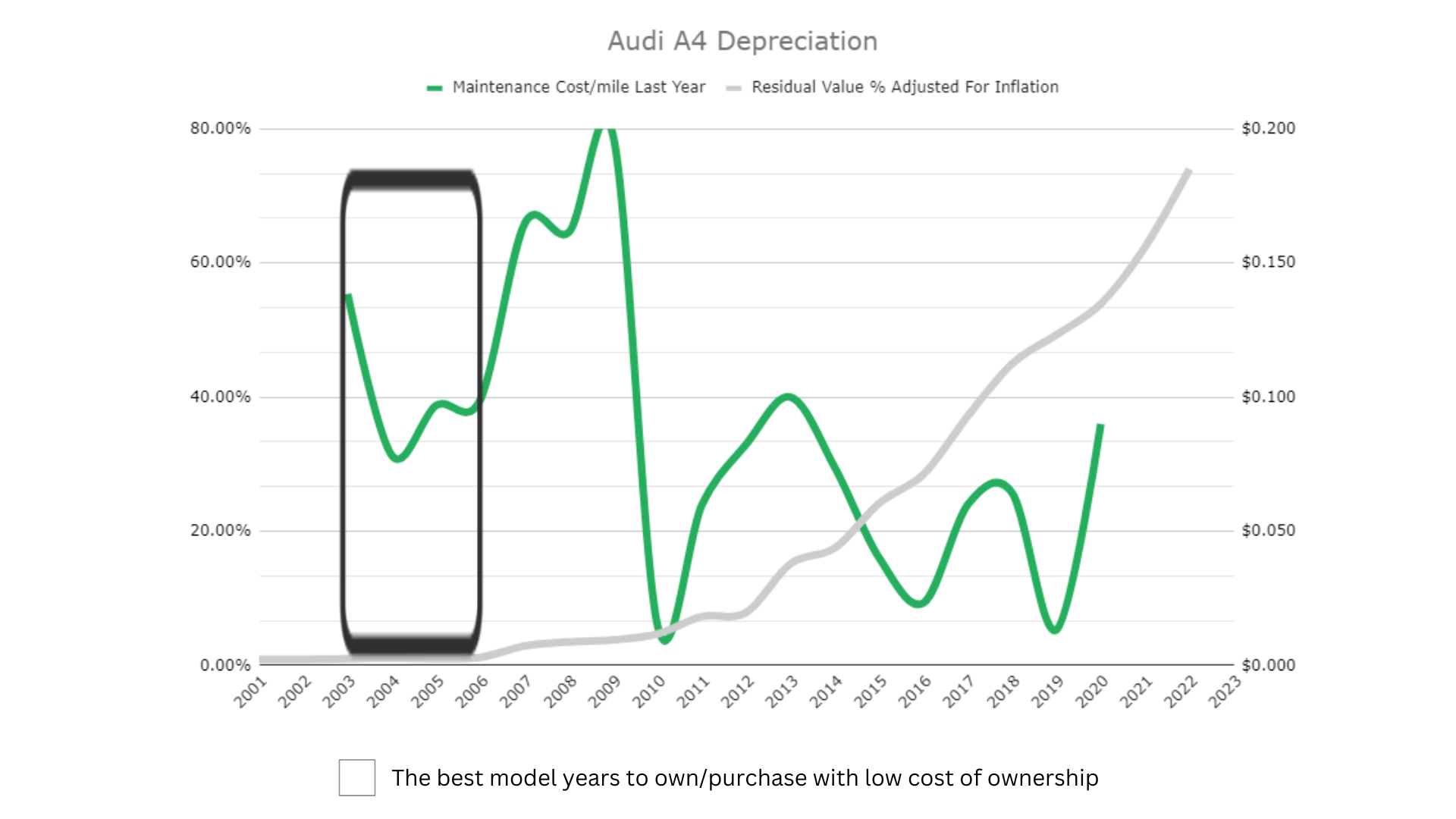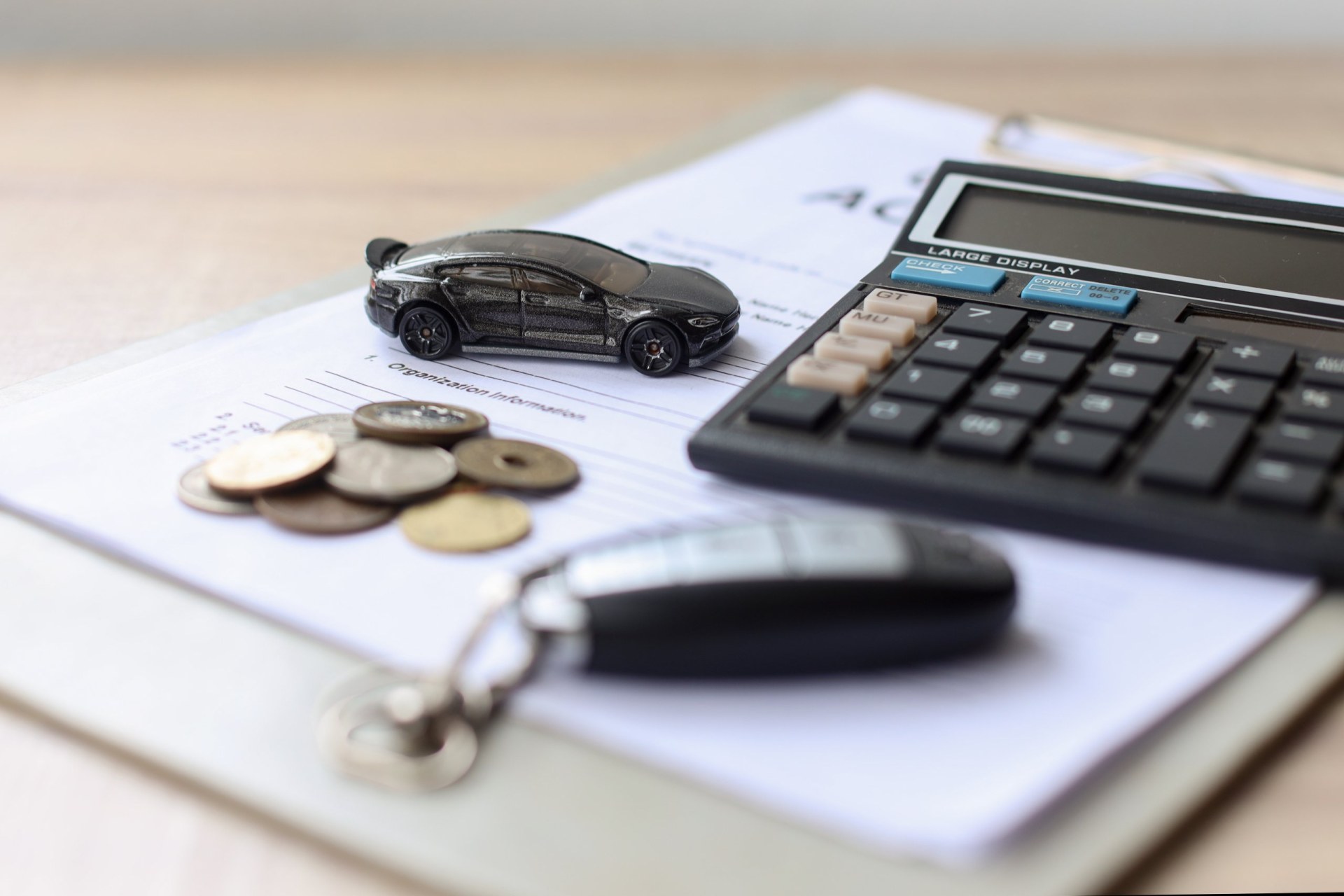Find the depreciation rate of your Audi A4 in the graph below.

To better understand the costs of owning a particular vehicle and its potential for holding value in the long term, it helps to be familiar with its depreciation rate and the factors that may contribute to this.
All vehicles depreciate, or lose value, over time, but depreciation doesn’t affect them all in the same way. On average, you can expect a new vehicle to lose about 22% of its initial value in the first year, and then slightly less in each successive year. After about five years, the depreciation rate tends to slow considerably. The Audi A4 generally follows that pattern, but its initial five-year depreciation is steeper than the norm.
Keep in mind that just because the vehicle costs the least to own in the sweet spot we have outlined here, you still may not want to own the vehicle during these depreciation sweet spot years. Although vehicles depreciate less as they get older, they have more repairs. Duh right? However, keep in mind that repairs don’t just cost you money, they cost you time. Reliability is the difference between being able to make it to your destination on time or missing an opportunity because the car broke down.
Check out our article on the best and worst years of the Audi A4 to see our reliability ratings for all years of the A4 between 2001-2022. We also cover MPG, safety ratings, and a number of other factors. We pulled data from A4s registered in our app and surveyed owners to get you data-backed answers on just how good or bad each year of the A4 is.
If you want to know the depreciation and maintenance costs for your particular vehicle, use our free “Total Cost of Ownership” tool available in the FIXD App – Android or IOS.
If you like our online tools and articles consider purchasing our FIXD sensor for $19.99 (this is 67% OFF). It’s our flagship product. With it, you scan your car for common engine problems.
If our sensor detects any problems with the engine, our app will clearly explain:
- What could have caused it and
- How much the possible repairs may cost.
If you’d like, we’ll even show you trusted repair shops in your area where you can get your ride fixed through RepairPal. The total cost of ownership feature within the app totals your maintenance costs, repairs, and depreciation (Sensor + App). This is free on the app.
Audi A4 Depreciation
| Model Years | Mileage | Amount Depreciated | Residual Value Percentage | Resale Value |
| 2001 | 264,000 | $30,477.08 | 0.9% | $275 |
| 2002 | 252,000 | $31,391.11 | 0.9% | $282 |
| 2003 | 240,000 | $32,100.48 | 1.0% | $325 |
| 2004 | 228,000 | $32,836.46 | 1.1% | $361 |
| 2005 | 216,000 | $32,985.67 | 1.0% | $330 |
| 2006 | 204,000 | $36,110.60 | 1.2% | $442 |
| 2007 | 192,000 | $35,826.11 | 2.9% | $1,083 |
| 2008 | 180,000 | $38,085.75 | 3.5% | $1,394 |
| 2009 | 168,000 | $38,770.96 | 3.8% | $1,540 |
| 2010 | 156,000 | $38,683.96 | 4.7% | $1,899 |
| 2011 | 144,000 | $37,577.61 | 7.3% | $2,963 |
| 2012 | 132,000 | $36,944.39 | 7.9% | $3,183 |
| 2013 | 120,000 | $33,663.40 | 15.2% | $6,037 |
| 2014 | 108,000 | $33,960.68 | 17.5% | $7,189 |
| 2015 | 96,000 | $32,580.68 | 24.2% | $10,386 |
| 2016 | 84,000 | $31,037.20 | 28.5% | $12,348 |
| 2017 | 72,000 | $26,547.50 | 37.2% | $15,734 |
| 2018 | 60,000 | $24,104.52 | 45.0% | $19,720 |
| 2019 | 48,000 | $22,980.10 | 49.3% | $22,379 |
| 2020 | 36,000 | $20,784.62 | 53.9% | $24,339 |
| 2021 | 24,000 | $16,747.91 | 62.4% | $27,818 |
| 2022 | 12,000 | $10,707.82 | 74.0% | $30,488 |
| 2023 | 0 | N/A | N/A | N/A |
The chart above conveys the approximate depreciation for an Audi A4. It draws on Kelley Blue Book data since 2001, assuming a vehicle in standard trim, a generic color such as black or white, and a mileage of 12,000 per year.
Keep in mind that the auto market was heavily affected in 2020 and beyond. Automakers selling new cars during the COVID pandemic raised prices which caused a spike in demand in the used car market as people tried to save money. Many automakers, however, did not drop prices after the pandemic, they kept them so they could make a larger profit.
This is why the most recent years of many vehicles have seemingly experienced less depreciation. Some may have even appreciated due to the heightened levels of inflation created.
Factors That Impact the Audi A4 Depreciation Rate

One factor that impacts vehicle depreciation is the reputation of the automaker. A better reputation generally yields a slower depreciation rate, but that’s not always the case, and Audi is a prime example of the exception.
According to Consumer Reports, almost every Audi vehicle is a “solid performer with a high-grade interior,” and new Audis are among the best in terms of brand reliability. Consumer Reports even highlights the A4 as being one of the top luxury compact sports sedans because of its exceptional driving experience. But Audi is also at the high end of the automotive market, and that has a bearing on long-term valuation. As U.S. News explains, luxury vehicles lose value more quickly because the target buyer doesn’t normally purchase secondhand cars.
Brand reputation and luxury status are just two things to consider. Here are some other important factors that impact a vehicle’s depreciation rate.
Age
Age refers to the model year, which is a designation assigned to a particular version of an automaker’s line. This means that a vehicle’s model year isn’t necessarily the same as the calendar year of its release. A common practice among automakers is to release vehicles to the market a few months before their assigned model years. For example, in some parts of the world, the 2020 A4 was available for purchase as early as the fall of 2019.
Newer model years are usually more valuable than older model years because they boast the newest, fastest, and most advanced technologies for enhancing the driving experience. That’s especially true for luxury models such as the A4, as the inclusion of high-end comforts is part of the branding. Given the rapidly evolving nature of technology, the difference in feature quality from one year to the next is tremendous, causing faster devaluation for earlier model years.
Such would be the case even with a brand-new A4. Imagine if you were to buy a 2023 model today only for Audi to release the 2024 model the following month. In far less than a calendar year, your practically new vehicle will have lost a significant portion of its value by virtue of being the outgoing model year.
Body Type
A vehicle’s body type refers to its shape and size. In the North American market, the popularity of smaller body types (sedans, coupes, and station wagons) has given way to larger ones (SUVs and pickup trucks). The Audi A4 is a sedan, which is a small passenger vehicle with four doors and a three-box configuration — engine, cab, and trunk. Given that, it may be likely to depreciate quickly because it belongs to a class that isn’t as popular as others.
Mileage
A vehicle’s mileage is an indicator of its wear and tear. Lower mileage suggests less use and, therefore, less strain on the vehicle. Higher mileage suggests the opposite. But mileage alone is just one part of the equation. By comparing it against the age of the vehicle and calculating mileage per year, you get a better sense of the use the car has seen.
Say you have a 2018 Audi A4 with 50,000 miles on it. As it’s a 5-year-old vehicle, that amounts to an average annual mileage of 10,000, which is less than the 12,000-mile-per-year average for all U.S. drivers, making it a low-mileage vehicle.
Overall Condition
A vehicle’s overall condition refers to how good it looks and how well it runs. To be in good condition, a vehicle must have no major mechanical issues or blemishes aside from those that arise from normal use. It should drive well, its body should be free of noticeable dents, and its upholstery should be intact.
You can keep your Audi A4 in good overall condition with a few good practices, including keeping up to date on maintenance. Regular maintenance tasks, such as oil changes and tire rotations, prevent major mechanical problems down the line. Another good practice is to drive safely. Avoiding accidents, even minor ones, helps prevent damage, whether on the interior or the exterior.
Color
A vehicle’s aesthetic appeal has a major influence on its resale value, which is why color is important. A 2023 study by iSeeCars found that yellow, beige, orange, and green vehicles depreciated more slowly than average, possibly because those are popular colors, but they aren’t common. Common colors such as white, blue, gray, and silver stuck close to the average, whereas brown and gold depreciated much faster. You may be able to preserve the value of your A4 by buying it in an appealing but less common shade.
Other Costs of Audi A4 Ownership
Aside from depreciation, there are two other major costs of ownership to consider.
Insurance
Vehicles that are more expensive, difficult to fix, or potentially unsafe are usually more costly to insure. The Audi A4 typically has good safety ratings, but its luxury status means a higher sticker price and, often, pricier repairs. The average cost of insuring an A4 is “,544 per year or 9 per month. That’s close to but under the average for all vehicles, which is “,630 per year, or 6 per month. Insurance rates vary by location, so make sure to check the rates in your part of the country.
Maintenance
The overall average cost of maintenance and repairs for the Audi A4 is $855 per year, which may seem high but is lower than the $900-plus average cost for luxury sedans in general. Some model years, though, are much lower. In particular, 2010-2011, 2015-2017, and 2019 are the cheapest model years, having annual costs as low as $250 and no higher than $500.
On the flip side, some model years cost more than the luxury car average. If you’d like to keep your maintenance costs down, consider avoiding these model years of the Audi A4, which have annual maintenance costs ranging from $1,125 to $1,750:
- 2007-2009
- 2013
The Best Model Year To Buy an Audi A4
Based on factors including price and reliability (but not depreciation), our choice for the best Audi A4 model years to buy are 2010 and 2013-2016, but check out our article on the best and worst years of the A4 to get the whole story.
The above-mentioned model years have many benefits. The 2010 A4 boasts an excellent safety rating and low cost of ownership, and with the 2013-2016 models, you get high owner reliability scores in addition to desirable safety features.
Buying an Audi A4 New vs. Used
| 20-Year Projection | ||
| Years Since Purchased | Depreciated Value | With Inflation |
| 1 | $29,822 | $32,922 |
| 2 | $25,147 | $29,386 |
| 3 | $21,722 | $25,516 |
| 4 | $19,868 | $23,425 |
| 5 | $18,135 | $21,280 |
| 6 | $14,992 | $17,547 |
| 7 | $11,486 | $13,464 |
| 8 | $9,753 | $11,500 |
| 9 | $7,053 | $8,344 |
| 10 | $6,126 | $7,325 |
| 11 | $3,184 | $3,870 |
| 12 | $2,942 | $3,677 |
| 13 | $1,894 | $2,409 |
| 14 | $1,531 | $1,968 |
| 15 | $1,411 | $1,786 |
| 16 | $1,169 | $1,465 |
| 17 | $484 | $605 |
| 18 | $403 | $507 |
| 19 | $443 | $555 |
| 20 | $403 | $496 |
A brand-new 2023 Audi A4 has a starting MSRP of $40,300. After driving it for three years, averaging 12,000 miles per year, the initial value will have depreciated to $21,722, which is a total accumulated depreciation of $18,578.30. In contrast, a 2021 A4 has a current value of $27,818, which represents an accumulated depreciation of $16,747.91 from an inflation-adjusted original MSRP of $44,565.91.
Comprehensive research can help make sure you get the best value on a used Audi A4. We recommend using the My Car’s Value tool by Kelley Blue Book to determine the approximate resale value of the vehicles you want. Make sure to factor in the other costs of ownership before you settle on a purchase.
Methodology
The data here applies to the base-level trim for every model year covered in the article. By focusing on the base trim, we’re able to create a standard against which to compare all the A4s from the past 22 years. Higher trim levels usually come with advanced features that increase the initial value of a vehicle and boost its appeal to secondhand buyers.
Keep in mind, there are large economic factors at play here too and the sale of new cars has caused shifts in the used market too. There is a stark difference in the cost of vehicles due to car manufacturers seeking higher profit margins after COVID as detailed by CNN and posted by CBS channel 58:
“… (T)he auto industry saw sky-high profits even as sales plummeted. Domestic manufacturers of cars and car parts saw a profit of $32 billion through the third quarter of 2022 (the latest data available) — their largest profit since 2016. Car dealerships also reported record-breaking profits through Q3, according to auto-retail advisers Haig Partners.
That’s because pandemic-era pent-up consumer demand remained strong as supply shifted, allowing automakers to increase their prices and their profit margins. Cars and trucks were sold nearly as soon as they hit dealership lots, and the average price paid for a vehicle in December soared to a near-record high of $46,382, according to J.D. Power.
Data from the Labor Department’s November Consumer Price Index shows American consumers are paying about 20% more for cars than they were in 2019.
The trend could continue into next year — research website Edmunds expects new-car sales to hit 14.8 million in 2023, a marginal increase from last year but well below pre-pandemic levels.
The auto industry has entered a new era: Less choice, higher prices and larger profit margins. So far it seems to be working for them.”
This shift by car companies to create higher profit margins by taking advantage of the heavily-reported-on chip shortage panic of COVID has had rebounding effects upon the value of used cars.
Be aware that newer years (the latest 3-4 model years) may be inflated in price because of this and depending on how big this problem is for the model you are considering – it may even be inflating the price of the older model years.
Frequently Asked Questions About Vehicle Depreciation
Do Audi A4s hold their value?
Being a luxury sedan, the Audi A4 doesn’t hold its value well. It loses 26% of its value in the first year of ownership, which is considerably higher than the average rate of 22% for all vehicles. After three years, it will have retained only about half of its original value.
Remember that there are other factors that impact a vehicle’s resale value. In addition to age, mileage, condition, and color, consider where and how you plan to sell your A4.
We can use the My Car’s Value tool by Kelley Blue Book to determine resale value by location and sale mode. Let’s say you have a silver 2020 Audi A4 40 Premium in good condition with 36,000 miles and with standard options. In New York City, that car might get you $20,958-$22,917 in a dealer trade-in and $24,204-$26,497 in a private sale. But in Anchorage, Alaska, you could net even more — $21,813-$23,772 in a trade-in and $25,373-$27,666 in a private sale.
What are the best years of the Audi A4 to buy, and which ones should you avoid?
Factoring in depreciation and the other costs of ownership, the best years for the Audi A4 are the 2002–2006 model years, as these lie in the ownership sweet spot. Some years to avoid include:
- 2007-2009
- 2011-2012
What's high mileage for an Audi A4?
Luxury vehicles often have lower overall mileage. According to our owner surveys, the average reported mileage for the Audi A4 is 111,685, and most A4s had mileage under 130,000. With that in mind, we’d say that anything above 130,000 qualifies as high mileage.
How old of an Audi A4 should you buy to avoid most of the depreciation?
Buying a 17-to-21-year-old Audi A4 should help you avoid most of the depreciation. That corresponds with the 2002-2006 model years. To maximize your time in the ownership sweet spot, consider the 2002 model year.
References
(2023.) Audi. Consumer Reports. Retrieved August 31, 2023, from https://www.consumerreports.org/cars/audi
(2023.) Audi A4. Consumer Reports. Retrieved August 31, 2023, from https://www.consumerreports.org/cars/audi/a4
(2023.) 10 Cars With the Fastest Depreciation in 2023. U.S. News. Retrieved August 31, 2023, from https://cars.usnews.com/cars-trucks/advice/cars-with-the-fastest-depreciation
(2023.) The Best and Worst Car Colors for Resale Value. iSeeCars. Retrieved August 31, 2023, from https://www.iseecars.com/car-color-study

At FIXD, our mission is to make car ownership as simple, easy, and affordable as possible. Our research team utilizes the latest automotive data and insights to create tools and resources that help drivers get peace of mind and save money over the life of their car.














